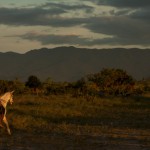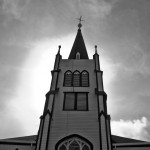As a tiny town in southern Guyana bordering Brazil, Lethem’s claim to fame is the annual Easter rodeo. With everyone in Georgetown talking only about the rodeo in the weeks leading up to Easter, I was left with little choice but to board a bus to Lethem.
500kms separates Georgetown from Lethem – 400 of which is mud. It doesn’t end there. Once you’ve resigned yourself to the fact that your vehicle will periodically get stuck in wet mud, you then have the bridges to contend with. Please note that these are no ordinary bridges. Made entirely from wood, they have a tendency to crumble under the weight of passing trucks. Bet the engineer didn’t see that one coming. Even after making allowances for these distractions, 30 hours to cover 500kms is shocking and a backbreaking experience.
Putting the horrible roads aside, the constantly changing landscape is breathtaking. Coastal vegetation slowly gives way to wet, untarnished and dense rainforest – the jaguar’s playground. Driving into southern Guyana, the forest seamlessly makes way for the savannah. And what a sight that is! Grass all around extending until the horizon, dotted with anthills and without a tree in sight. An anteater’s paradise.
The annual Easter rodeo features a blend of Guyanese and Brazilian cultures with some Jamaican music thrown in for good measure. Entertainment for the weekend includes wild horse riding, wild bull riding, wild cow milking, greasy pig catching and greasy pole climbing among other attractions. All this under the scorching sun. Something about watching grown men foolishly attempt to ride wild animals and then fail miserably makes for a great afternoon. Nightfall sees the music being cranked up to keep pace with the drunken celebrations.
Moca Moca waterfalls fall into the rocky stream rather than gigantic waterfall category. Huge pools of water and large rocks encourage cannonballs. Picture this for a lazy Sunday afternoon – sitting by the edge of a creak bathing in sunlight diffusing through tall trees and your legs immersed in cold stream water. Perfection would require a cold beer. Maybe next time. Not so sure why anyone would leave all this behind to climb 1000 stairs to the top of a mountain, braving the sun and risking drowning in your own sweat. The ‘peak’ (for lack of a better word) offers a spectacular view of the savannah and a few green hills. However, the intense heat makes the waterfall preferable.
A trip to Lethem should be on the cards of any tourist in Guyana. While the rodeo may not be around the rest of the year – a stop at the Iwokrama forest for a canopy walk or a dash across the border into the Brazilian towns of Bom Fin and Boa Vista seem like reasonable alternatives. Caiperinjas anyone?
Objective – To produce the best rum in the World
Ferment > Distil > Age > Consume
Stage 1 – Ferment

Input – yeast, molasses, water
Equipment – huge vats and lots of large pipes (preferably intertwined in a complicated manner)
Procedure
- Grow yeast in huge vats by maintaining perfect conditions for replication. Mood music not necessary. Estimated time – 6 hours.
- Mix yeast with molasses and water.
- Throw in anti foaming substance for good measure. Add sulfuric acid to taste. Keep temperature below 37 degrees.
- Leave the mixture alone for 24 hours.
Output – Carbon dioxide and dead wash
Stage 2 – Distil

Input – dead wash and steam
Equipment – Stills, condensers, pipes, glass beakers, pipettes and log books
Procedure
Equipment – Stills, condensers, pipes, glass beakers, pipettes and log books
Procedure
- Transfer the dead wash from fermenting plant into huge cylindrical stills while blowing steam through these stills to vaporize the dead wash. These fumes are then converted into pure alcohol in the condenser.
- Different stills give flavors to the alcohol. Coffey, wooden and pot stills are some still options.
- Mad scientist equipment helps staff monitor the consistency of the alcohol.
- Once the alcohol has been extracted, dump all waste into the river*. Don’t let your conscience bother you about that. The law sure as hell won’t.
Output – 18 different alcohol varieties with varying consistencies, compositions, flavours and colours.
Stage 3 – Age

Input – pure alcohol from stage 2
Equipment – Wood, iron, rain, sunshine
Procedure
Equipment – Wood, iron, rain, sunshine
Procedure
- Mix different quantities of different rums to produce a rum blend. Adult supervision required.
- Build a casket from the wood using iron clamps and leave it out in the rain for a few days to ensure that the wood absorbs water and binds together well.
- Air pressure test the cask before sealing blended rum in it for up to 80 years in some cases. Your kids will thank you for your patience.
Output – The world’s best rum
Stage 4 – Consume

Conclusion – Demarara distilleries produces 20,000 bottles of rum per day. The warehouse unit houses more than 36,000 caskets of rum. El Dorado 5 year rum is the best rum in the below 7 year category and has won that award over the last 7 years. El Dorado 15 year rum is the best rum. Period. Our friendly neighbourhood rum connoisseur observed (and I concur) that the following mapping holds true for good rums
- 21 years = cognac
- 15 years = scotch
- 12 years = brandy
- 6 years = vodka
- 5 years = tequila
- 3 years = rum rum
* The distillery has opened a new bio gas plant next door to the distillery and is using its waste to generate bio fuel to power the distillery. The CO2 released from the fermentation is used to make dry ice and Pepsi. Although these practices are somewhat sustainable, the brown waste flowing into the river shows that this token effort isn’t enough and there’s a lot of work to be done on this front.
On landing at the Cheddi Jagan International airport in Guyana, the Calypso playing on the speakers sets the expectations right. Georgetown may be part of South America but make no mistake – you’re in the Caribbean!!
First Glance
Georgetown stands a good chance of being the world’s laziest city (if it can be called a city). With a population of 200,000 the roads are relatively empty and traffic rules non-existent. 200 years of colonial mud-slinging between the British, French, Portuguese and Dutch has given Georgetown a more than colorful history. The eclectic mix of churches and buildings dotting the town bear witness to that. Like most of the buildings around, my guest house is built completely from wood. Living on the 2nd floor of a rickety wooded building rocks. Literally. Somewhere in the house a door slams shut and the entire building seems to shake on its foundation (if any).
The Best Part
The 45km drive from the airport to Georgetown offers an intoxicating scent of both rum and beer distilleries which are part of Guyana’s largest industry (sugarcane – rum…same thing). Guyana’s rum – El Dorado has brought home numerous awards for one of the world’s best rums. Even more reason to not complain about rum being cheaper than Coke in these parts. Did you know that Guinness brews its beer in Georgetown?? A tour of the rum distillery is battling the Kaieteur falls (world’s largest single drop waterfall) for top spot on my tourist agenda.
Lifestyle
Music’s in the air at all points in time right from the street CD vendors to food stalls to passing vehicles. People even seem to sing as they speak. Seems fitting for the Caribbean. This musical passion is possibly overshadowed by only one other countrywide obsession – cricket. With the world cup going on, the only thing playing on all televisions is repeats of older cricket matches. Even though the West Indies were knocked out in the quarterfinals, people still seem interested. Random people were hugging each other at a local food court when India won the World Cup. Didn’t seem to make any sense. I think I’m going to like it here.
Cost of Living
a) Beer – USD 1.5 at posh places and USD 1 at local bars
b) Call a cab – USD 1.5 from anywhere to anywhere
c) Cab off the street – USD 2 from anywhere to anywhere (don’t ask why)
d) Rum – USD 4-5 per bottle
e) Big night out – USD 15 (including dinner)
f) Big Mac – dream on
The Downside
Hot water showers are a rather elusive commodity here and can only be found at the swankiest hotel in town. Regular mortals and underpaid volunteers have to suck it up and jump into moss ridden cold showers. Wireless internet made it’s way to Georgetown just fine, but somehow washing machines didn’t.
Right now – belly full behind drunk*. Time for some shut eye.
*Local proverb: eat + drink = laziness







































